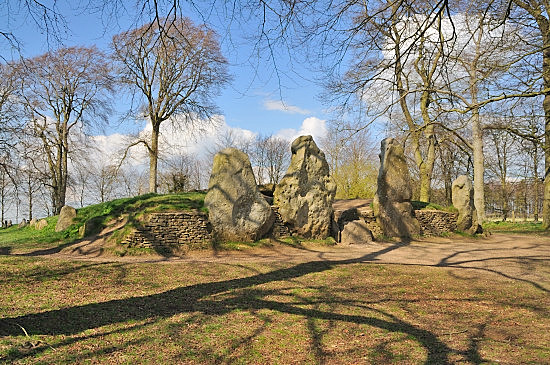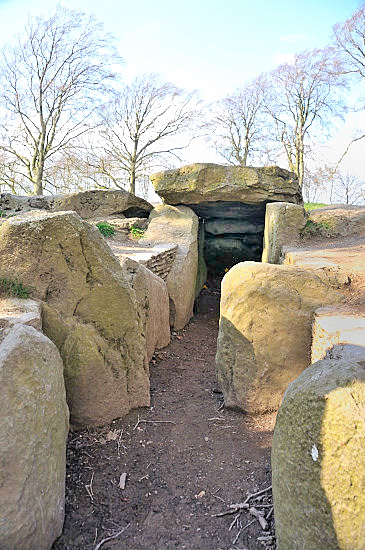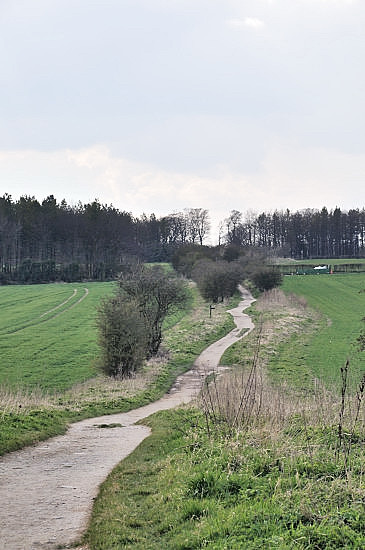Wayland's Smithy
Near Uffington,
Oxfordshire
|

Location Guide
 |
Wayland Smithy, is a smaller multi chambered
long barrow just to the north and accessible off the Ridgeway, located
within walking distance for anyone from
Uffington
White Horse
 and Uffington Castle.
and Uffington Castle.

 
There are a number of these long barrows, often
collectively called the Severn-Cotswold tombs, passage graves or multi chambered
long barrows. Some can be found on the Marlborough Downs some on the Cotswolds,
others near Stroud and quite a few in Somerset. They vary is size from the
West Kennet Long Barrow,  which is the largest and best preserved, to small ones with multiple entrances
that are difficult to enter. It is likely that some remains at other
places around the UK were of a similar design before the earth was eroded away,
and some stone circles are the remains of these as well. The basic design
is a number of upright stones, creating a passage with side chambers off,
and larger flat rocks balanced on top of these, with smaller stones used to
infill the holes. The whole lot is then covered with earth. A stone front is often
then found around the main entrance and this may have a blocking stone at
the front. Some have a major entrance that turns out to be a dummy, the main
entrance being elsewhere. Some are edged in stones.
which is the largest and best preserved, to small ones with multiple entrances
that are difficult to enter. It is likely that some remains at other
places around the UK were of a similar design before the earth was eroded away,
and some stone circles are the remains of these as well. The basic design
is a number of upright stones, creating a passage with side chambers off,
and larger flat rocks balanced on top of these, with smaller stones used to
infill the holes. The whole lot is then covered with earth. A stone front is often
then found around the main entrance and this may have a blocking stone at
the front. Some have a major entrance that turns out to be a dummy, the main
entrance being elsewhere. Some are edged in stones.
There is an assumption that they were graves, as
some have had skeletons found in them. In some case a large number of skeletons,
in others just the remains of a single person or a couple. There is the
possibility that some at least were originally the insulated and safe part of a
house with rooms for keeping either items safe, food at a cooler temperature or
just a place that you could go so as not to freeze in winter. In Cornwall and
some other places ancient stone villages had underground cave like structures
connected to some houses or as a feature within the community. They may have
been reused as graves later or perhaps the entrance was sealed to keep out the
cold and the occupants suffocated, making it their grave.
|
Wayland's Smithy, is thought to have first been
built as a multi cambered oval barrow structure, around 25 by 45ft, around
3,700BC (over 5,700 years ago) in this phase it had a stone floor, wooden walls
and stone edging. It was modified and the stone chambered long barrow built in
front and over the older one, so the first one is evident now only by slight
bowing and some stones on the edges. This second development was around 300
years later in around 3,400 BC. It was restored to look like it does today in
1963. The mound is 185ft long and 43ft wide at the widest southern
end, where the entrance is. The edge has a stone curb around it. The earth comes
from two flanking ditches that are about 60 foot long. Post holes at the
entrance end suggest a building or larger front existed. There are two side
chambers and one main chamber. The front has 4 large Sarsens, there were
originally six but two have disappeared over time.
In the centre of these Sarsens is a
stone-lined passage that leads to the entrance, which itself, is formed by
two opposing pillars, standing about 5ft tall, with two shorter
pillars beyond these. The far wall is sealed by horizontally-stacked stones,
and overhead a large slab forms the roof. The two burial chambers oppose
each other on either side of this passageway, and the entrances to each are
formed by the gaps in between the two sets of pillars. These chambers,
similarly stone-clad with separate slabs forming their roof, are very
confined and can only be entered in a squatting position.
Remains found in the inner first barrow include
eleven men, two women, and a child, and its likely that they were later brought
here, not being where either they died or where brought immediately, because
most had a violent death, 3 were killed by arrows, and 2 had been part
eaten by animals before being buried here.
|

 |
 |
Remains of around 7 adults and a child were
found in the second stone lined version.
There is a
legend that if you leave a horse tied up at it over night, and a silver coin
left, when you come back in the morning it will have new shoes. Wayland's
Smithy is one of many prehistoric sites associated with Wayland or 'Wolund',
the Norse and Saxon God of blacksmithing, perhaps suggesting this legend goes
back a long way.
Today we think of the Smithy as a farrier,
shoeing horses, a tradesman, but historically the blacksmith was the
scientist, developer, and a very important person in the community.
Even toady you can get married in Scotland, at
Gretna in a blacksmiths shop, and the original ring was not one that went on
your finger but the ring of the blacksmith striking the anvil marking the
completion of a marriage agreement. Its also probably the origin of an
auctioneer bringing down the hammer on a deal, and many other traditions.
Wayland's Smithy can be reached from the
Ridgeway Path, located a short walk south, towards Barbury and Avebury. If
visiting the white horse and castle at Uffington then this is a short
walk south, and on the way back there is a short cut back to the car
park.
 |
|
For more images see
our gallery using this button
 |
|
|

|
Please let us know any other information that we
can add to the Grid(s) or page and any errors that you discover. Before making a long trip to any location it is always
wise to double check the current information, websites like magazines may be
correct at the time the information is written, but things change and it is of
course impossible to double check all entries on a regular basis. If you have
any good photographs that you feel would improve the illustration of this page
then please let us have copies. In referring to this page it is helpful if you
quote both the Page Ref and Topic or Section references from the Grid below. To print the
planning grid select it then right click and print the selected area.
Please submit information on locations you discover so
that this system continues to grow.
|